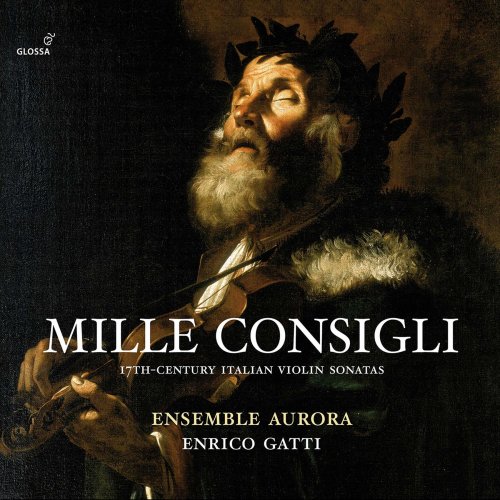
Ensemble Aurora, Enrico Gatti - Mille consiglie: 17th Century Italian Violin Sonatas (2020)
BAND/ARTIST: Ensemble Aurora, Enrico Gatti
- Title: Mille consiglie: 17th Century Italian Violin Sonatas
- Year Of Release: 2020
- Label: Glossa
- Genre: Classical
- Quality: FLAC (tracks)
- Total Time: 01:18:48
- Total Size: 387 MB
- WebSite: Album Preview
Tracklist:
1. 18 Sonatas in 1, 2, 3 Parts: No. 2 in D Major (7:14)
2. Canticum Canticorum: No. 22, Puclhra es, amica mea (Arr. for Chamber Ensemble) (5:12)
3. Ciaccona in C Major (9:37)
4. Toccata No. 10 for Theorbo (3:10)
5. 18 Sonatas in 1, 2, 3 Parts: No. 12 in F Major (5:41)
6. Vestiva i colli (Arr. for Violin & Organ) (4:31)
7. Canzoni da suonare, Op. 17: No. 14, La cappellina (3:34)
8. Sonate over canzoni, Op. 5: No. 11 for Violin (6:38)
9. Sonata No. 2 for Bassoon (10:06)
10. Toccata No. 7 for Keyboard (5:14)
11. 18 Sonatas, Op. 2: No. 8, La foscari (3:02)
12. Ozio regio, Op. 7: No. 3, Sonata for Violin (9:53)
13. Sonata No. 8 for Violin & Bassoon (5:01)
1. 18 Sonatas in 1, 2, 3 Parts: No. 2 in D Major (7:14)
2. Canticum Canticorum: No. 22, Puclhra es, amica mea (Arr. for Chamber Ensemble) (5:12)
3. Ciaccona in C Major (9:37)
4. Toccata No. 10 for Theorbo (3:10)
5. 18 Sonatas in 1, 2, 3 Parts: No. 12 in F Major (5:41)
6. Vestiva i colli (Arr. for Violin & Organ) (4:31)
7. Canzoni da suonare, Op. 17: No. 14, La cappellina (3:34)
8. Sonate over canzoni, Op. 5: No. 11 for Violin (6:38)
9. Sonata No. 2 for Bassoon (10:06)
10. Toccata No. 7 for Keyboard (5:14)
11. 18 Sonatas, Op. 2: No. 8, La foscari (3:02)
12. Ozio regio, Op. 7: No. 3, Sonata for Violin (9:53)
13. Sonata No. 8 for Violin & Bassoon (5:01)
There is always poetry as well as virtuosity coursing through Enrico Gatti’s violin playing, and nowhere more so than when he turns to Italian early Baroque music, as here in Mille consigli with his Ensemble Aurora: the album title reflecting the multiplicity of emotional ideas and colours possible in violin music from this time (Gatti’s earlier recordings of similar music have recently been re-released by Glossa as L’arte del violino in Italia).
Each of the other members of Ensemble Aurora – Elena Bianchi on dulcian, Gabriele Palomba on theorbo and Fabio Ciofini on the organ – also get their own opportunity to display their talents in a joyous and warm exploration of Sonatas, Toccatas and similar music written by composers such as Castello, Legrenzi, Merula, Fontana and Michelangelo Rossi in the first half of the 17th century.
Amongst Baroque stylistic practices beginning to emerge and flourish at the time, the basso continuo was gaining increasing importance. Linked strongly to the specific characteristics of the Italian organ (which, according to Daniele Torelli, the writer of Glossa’s booklet essay, were to remain essentially unchanged until the 19th century), the melodic and harmonic functions of the basso continuo were frequently called upon for instrumental music in churches. Fabio Ciofini provides an exemplary lesson here in accompanying on the restored 1647 Luca Neri organ in the church of San Nicolò in Collescipoli.
Each of the other members of Ensemble Aurora – Elena Bianchi on dulcian, Gabriele Palomba on theorbo and Fabio Ciofini on the organ – also get their own opportunity to display their talents in a joyous and warm exploration of Sonatas, Toccatas and similar music written by composers such as Castello, Legrenzi, Merula, Fontana and Michelangelo Rossi in the first half of the 17th century.
Amongst Baroque stylistic practices beginning to emerge and flourish at the time, the basso continuo was gaining increasing importance. Linked strongly to the specific characteristics of the Italian organ (which, according to Daniele Torelli, the writer of Glossa’s booklet essay, were to remain essentially unchanged until the 19th century), the melodic and harmonic functions of the basso continuo were frequently called upon for instrumental music in churches. Fabio Ciofini provides an exemplary lesson here in accompanying on the restored 1647 Luca Neri organ in the church of San Nicolò in Collescipoli.
Download Link Isra.Cloud
Enrico Gatti - Mille consiglie_ 17th Century Italian Violin Sonatas FLAC.rar - 387.1 MB
Enrico Gatti - Mille consiglie_ 17th Century Italian Violin Sonatas FLAC.rar - 387.1 MB
Year 2020 | Classical | FLAC / APE
As a ISRA.CLOUD's PREMIUM member you will have the following benefits:
- Unlimited high speed downloads
- Download directly without waiting time
- Unlimited parallel downloads
- Support for download accelerators
- No advertising
- Resume broken downloads


